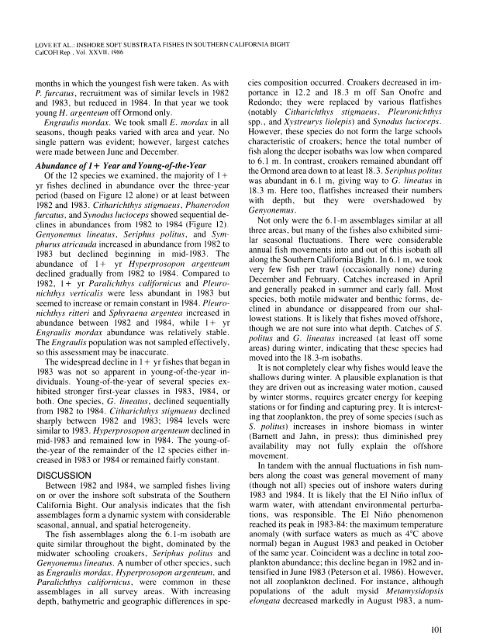CalCOFI Reports, Vol. 27, 1986 - California Cooperative Oceanic ...
CalCOFI Reports, Vol. 27, 1986 - California Cooperative Oceanic ...
CalCOFI Reports, Vol. 27, 1986 - California Cooperative Oceanic ...
- No tags were found...
Create successful ePaper yourself
Turn your PDF publications into a flip-book with our unique Google optimized e-Paper software.
LOVE ET AL.: INSHORE SOFT SUBSTRATA FISHES IN SOUTHERN CALIFORNIA BIGHTCalCOFl Rep., <strong>Vol</strong>. XXVII. <strong>1986</strong>months in which the youngest fish were taken. As withP. furcatus, recruitment was of similar levels in 1982and 1983, but reduced in 1984. In that year we tookyoung H. argenteurn off Ormond only.Engraulis rnordax. We took small E. inordux in allseasons, though peaks varied with area and year. Nosingle pattern was evident; however, largest catcheswere made between June and December.Abundance of I + Year and Young-of-the-YearOf the 12 species we examined, the majority of 1 +yr fishes declined in abundance over the three-yearperiod (based on Figure 12 alone) or at least between1982 and 1983. Citharichthys stigmueus, Phanerodonfurcatus, and Synodus lucioceps showed sequential declinesin abundances from 1982 to 1984 (Figure 12).Genyonernus lineatus, Seriphus politus, and Syrnphurusatricauda increased in abundance from 1982 to1983 but declined beginning in mid-1983. Theabundance of 1 + yr Hyperprosopon argenteumdeclined gradually from 1982 to 1984. Compared to1982, 1 + yr Puralichthys calijornicus and Pleicrorzichthysverticalis were less abundant in 1983 butseemed to increase or remain constant in 1984. Pleuronichthysritteri and Sphyraena argentea increased inabundance between 1982 and 1984, while I + yrEngraulis mordax abundance was relatively stable.The Engraulis population was not sampled effectively,so this assessment may be inaccurate.The widespread decline in 1 + yr fishes that began in1983 was not so apparent in young-of-the-year individuals.Young-of-the-year of several species exhibitedstronger first-year classes in 1983, 1984, orboth. One species, G. lineatus, declined sequentiallyfrom 1982 to 1984. Citharichthys stigrnaeus declinedsharply between 1982 and 1983; 1984 levels weresimilar to 1983. Hyperprosopon argenteurn declined inmid-I983 and remained low in 1984. The young-ofthe-yearof the remainder of the 12 species either increasedin 1983 or 1984 or remained fairly constant.DISCUSS IONBetween 1982 and 1984, we sampled fishes livingon or over the inshore soft substrata of the Southern<strong>California</strong> Bight. Our analysis indicates that the fishassemblages form a dynamic system with considerableseasonal, annual, and spatial heterogeneity.The fish assemblages along the 6. I-m isobath arequite similar throughout the bight, dominated by themidwater schooling croakers, Seriphus politits andGenyonemus lineatus. A number of other species, suchas Engraulis rnordax, Hyperprosopon argenteurn, andParalichthys californicus, were common in theseassemblages in all survey areas. With increasingdepth, bathymetric and geographic differences in spe-cies composition occurred. Croakers decreased in importancein 12.2 and 18.3 m off San Onofre andRedondo; they were replaced by various flatfishes(notably Citharichthys stigmaeus, Pleuronichthysspp., and Xystreurys liolepis) and Synodus lucioceps.However, these species do not form the large schoolscharacteristic of croakers; hence the total number offish along the deeper isobaths was low when comparedto 6.1 m. In contrast, croakers remained abundant offthe Ormond area down to at least 18.3. Seriphus polituswas abundant in 6.1 m, giving way to G. lineatus in18.3 m. Here too, flatfishes increased their numberswith depth, but they were overshadowed byGenyonernus.Not only were the 6.1-m assemblages similar at allthree areas, but many of the fishes also exhibited similarseasonal fluctuations. There were considerableannual fish movements into and out of this isobath allalong the Southern <strong>California</strong> Bight. In 6.1 m, we tookvery few fish per trawl (occasionally none) duringDecember and February. Catches increased in Apriland generally peaked in summer and early fall. Mostspecies, both motile midwater and benthic forms, declinedin abundance or disappeared from our shalloweststations. It is likely that fishes moved offshore,though we are not sure into what depth. Catches of S.politus and G. lineatus increased (at least off someareas) during winter, indicating that these species hadmoved into the 18.3-m isobaths.It is not completely clear why fishes would leave theshallows during winter. A plausible explanation is thatthey are driven out as increasing water motion, causedby winter storms, requires greater energy for keepingstations or for finding and capturing prey. It is interestingthat zooplankton, the prey of some species (such asS. politus) increases in inshore biomass in winter(Barnett and Jahn, in press); thus diminished preyavailability may not fully explain the offshoremovement.In tandem with the annual fluctuations in fish numbersalong the coast was general movement of many(though not all) species out of inshore waters during1983 and 1984. It is likely that the El Nifio influx ofwarm water, with attendant environmental perturbations,was responsible. The El Niiio phenomenonreached its peak in 1983-84: the maximum temperatureanomaly (with surface waters as much as 4°C abovenormal) began in August 1983 and peaked in Octoberof the same year. Coincident was a decline in total zooplanktonabundance; this decline began in 1982 and intensifiedin June 1983 (Peterson et al. <strong>1986</strong>). However,not all zooplankton declined. For instance, althoughpopulations of the adult mysid Metamysidopsiselongata decreased markedly in August 1983, a num-101















